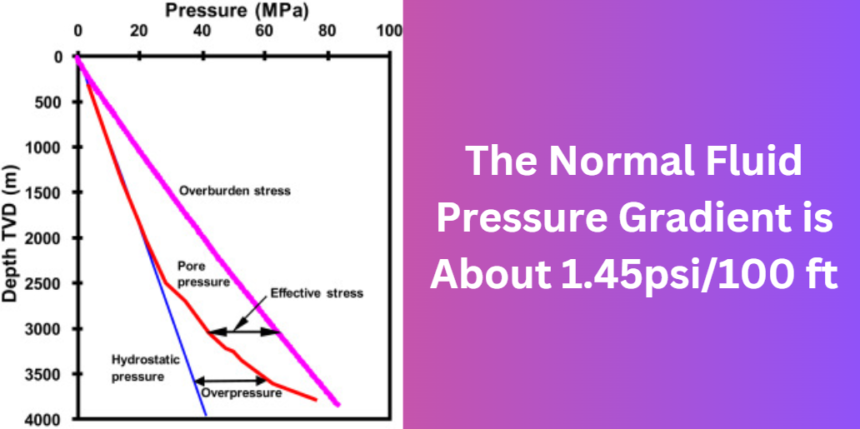Understanding fluid pressure gradients is fundamental in various engineering fields, especially in petroleum engineering and hydrogeology. This guide provides a comprehensive analysis of the statement “the normal fluid pressure gradient is about 1.45psi/100 ft,” exploring its derivation, significance, and potential discrepancies compared to more conventional values. Through detailed explanations, step-by-step calculations, comparative tables, and real-world applications, this article aims to offer clarity and depth on this topic.
Overview of the Topic
Pressure gradients refer to the change in pressure with respect to a change in depth. In most hydrostatic scenarios, the pressure gradient is determined by the fluid’s density and gravitational forces. Conventional wisdom suggests that water, for example, typically has a pressure gradient of about 0.433 psi per foot, which equates to roughly 43.3 psi per 100 ft. In stark contrast, the value of 1.45 psi per 100 ft is dramatically lower. This article delves into how such a value might be derived, what conditions could lead to this lower gradient, and how it compares to the standard calculations.
Key Definitions and Terminology
Before diving deeper, it is important to define a few key terms:
- Hydrostatic Pressure: The pressure exerted by a fluid at rest due to gravity.
- Pressure Gradient: The rate of pressure change with respect to distance (in this case, depth).
- Density: The mass per unit volume of a fluid, which directly influences the pressure gradient.
- psi (pounds per square inch): A unit of pressure.
Fundamentals of Fluid Pressure Gradients
Basic Principles of Hydrostatic Pressure
Fluid pressure increases with depth due to the weight of the overlying fluid. The basic hydrostatic equation is expressed as:
P=ρ×g×hP = \rho \times g \times h
where PP is the pressure, ρ\rho is the fluid density, gg is the acceleration due to gravity, and hh is the depth. For water, with an approximate density of 62.4 lb/ft³ and a gravitational constant of 32.2 ft/s², the pressure increases at roughly 0.433 psi per foot. This forms the basis for most calculations in fluid mechanics.
How Pressure Gradients Are Calculated
The pressure gradient is simply the pressure difference per unit change in depth. For water, this calculation is straightforward:
- Pressure increase per foot = 0.433 psi/ft
- Pressure increase per 100 feet = 0.433 psi/ft × 100 ft = 43.3 psi/100 ft
When we encounter a figure such as 1.45 psi/100 ft, it implies a pressure increase of only 0.0145 psi per foot. This discrepancy suggests that the fluid in question, or the conditions under which this measurement was taken, are significantly different from those typically assumed in standard hydrostatic conditions.
Units and Conversions
Understanding the relationship between different units is essential. A simple table comparing common fluids under standard conditions illustrates this:
| Fluid Type | Typical Density (lb/ft³) | Pressure Gradient (psi/ft) | Pressure Gradient (psi/100 ft) |
|---|---|---|---|
| Freshwater | ~62.4 | ~0.433 | ~43.3 |
| Seawater | ~64 | ~0.445 | ~44.5 |
In contrast, the gradient of 1.45 psi/100 ft would require a very low-density fluid or unique measurement conditions that are not typical for most subsurface fluids.
Conventional Fluid Pressure Gradients
Standard Values for Common Fluids
For most practical applications, the hydrostatic pressure gradient for freshwater is accepted as approximately 43.3 psi per 100 ft. This value is derived from the known properties of water and serves as a baseline in many engineering calculations. Deviations from this norm are usually attributed to variations in fluid density, temperature, or measurement error.
Contrasting with the 1.45psi/100 ft Value
The assertion that “the normal fluid pressure gradient is about 1.45psi/100 ft” stands in stark contrast to the conventional understanding. If we assume standard gravitational and density values, a gradient of 1.45 psi per 100 ft implies an extremely low-density fluid or an unusual experimental setup. This section explores the possible reasons behind such a figure, including laboratory conditions, specialized fluids, or even typographical errors in published data.
Analyzing the Statement: “The Normal Fluid Pressure Gradient is About 1.45psi/100 ft”
Possible Interpretations and Contexts
There are several scenarios in which the value of 1.45 psi/100 ft might be applicable. One possibility is that the fluid in question is not water but a much lighter fluid—perhaps a gas or a specially engineered liquid with low density. Alternatively, the measurement might have been taken under controlled laboratory conditions where standard gravitational effects were altered or where the fluid’s properties were modified. Another interpretation is that this value could be the result of a misprint or a conversion error in some texts.
Unit Analysis and Conversion Issues
To understand the discrepancy, one must carefully analyze the units involved. The standard water gradient of 43.3 psi/100 ft (or 0.433 psi/ft) is based on well-established principles. To achieve a gradient of 1.45 psi/100 ft, the required fluid density would have to be significantly lower. By rearranging the hydrostatic equation, one can estimate the density needed for such a low gradient. This analysis often reveals that either a different fluid is being considered or that the value is the result of an error in unit conversion.
Industry or Research-Specific Assumptions
In some niche research areas or specialized industries, measurements may be reported using non-standard fluids or under non-standard conditions. It is possible that in a particular study or application, the value of 1.45 psi/100 ft was observed or calculated based on unique experimental parameters. Understanding these conditions is crucial for interpreting the measurement correctly and for applying it in a practical context.
Detailed Calculations and Methodologies
Derivation of Hydrostatic Pressure
A detailed calculation begins with the hydrostatic pressure formula:
P = ρ × g × h
For water, using ρ ≈ 62.4 lb/ft³ and g ≈ 32.2 ft/s², the calculation yields a pressure increase of approximately 0.433 psi per foot. For a depth of 100 ft, this results in:
Pressure = 0.433 psi/ft × 100 ft = 43.3 psi
Worked Example for a Hypothetical Fluid
To derive a gradient of 1.45 psi per 100 ft (or 0.0145 psi/ft), we can reverse-engineer the equation. Assuming standard gravitational acceleration, the required density would be calculated as follows:
Density = (Pressure Gradient) / (g × Conversion Factor)
If we let the conversion factor be the standard units for psi, the resulting density would be anomalously low compared to that of water. This reinforces the idea that such a low gradient must correspond to a fluid with very different properties or to a measurement under specialized conditions.
Tables and Charts for Clarity
Consider the following table that contrasts typical hydrostatic gradients with the 1.45 psi/100 ft value:
| Parameter | Freshwater Calculation | Hypothetical Fluid Calculation (1.45 psi/100 ft) |
|---|---|---|
| Pressure Gradient (psi/ft) | 0.433 | 0.0145 |
| Pressure Increase (psi/100 ft) | 43.3 | 1.45 |
| Implied Fluid Density | ~62.4 lb/ft³ | Significantly lower than 62.4 lb/ft³ |
Charts comparing these gradients can visually illustrate how fluid properties dramatically affect pressure calculations.
Applications and Implications in Industry
Relevance in Petroleum Engineering
Understanding the correct pressure gradient is critical in drilling operations and reservoir management. For instance, an underestimation or overestimation of formation pressure can lead to well control problems. Engineers rely on accurate pressure gradients to design drilling mud programs and to predict subsurface behavior accurately.
Hydrogeology and Groundwater Flow Models
In groundwater studies, pressure gradients drive the movement of water through aquifers. Misinterpreting the normal fluid pressure gradient could lead to errors in modeling groundwater flow, impacting water resource management and environmental assessments.
Safety and Operational Protocols
Accurate pressure measurements are vital for maintaining operational safety. Incorrect assumptions about pressure gradients may result in failures in well design or blowout preventers, leading to catastrophic failures and environmental hazards.
Discrepancies, Misinterpretations, and Common Errors
Typographical and Conversion Mistakes
The occurrence of a value like 1.45 psi/100 ft can often be traced back to typographical errors or unit conversion mistakes. A careful review of the literature reveals that such errors can propagate if not critically evaluated.
Critical Evaluation of Sources
Engineers and researchers must cross-check reported pressure gradients with established standards. Evaluating multiple sources—ranging from academic textbooks to industry guidelines—helps in identifying and correcting errors in the reported data.
Real-World Case Studies
Instances where the misinterpretation of pressure gradients led to operational issues provide practical lessons. Analyzing these case studies emphasizes the importance of precision in measurements and the potential consequences of relying on erroneous data.
Comparison with Alternative Models and Theories
Review of Competing Pressure Gradient Models
There are alternative models used to calculate pressure gradients, some of which account for variable fluid properties or non-standard gravitational conditions. Comparing these models with the standard hydrostatic calculation can highlight both advantages and limitations.
Advantages and Limitations
While the standard hydrostatic model is straightforward and widely accepted, alternative models may provide more accurate predictions under certain conditions. However, for most practical applications, the standard model remains the most reliable unless specific circumstances dictate otherwise.
Expert Opinions and Academic Research
Insights from academic research and expert interviews suggest that discrepancies like the 1.45 psi/100 ft figure are rare and context-specific. These expert opinions help to contextualize the value within the broader field of fluid mechanics and underscore the importance of understanding measurement conditions.
Future Directions and Research Opportunities
Emerging Technologies in Measurement
Advances in sensor technology and data analytics are paving the way for more precise measurements of fluid pressure gradients. These emerging technologies promise to reduce errors and enhance the reliability of pressure data in both laboratory and field settings.
Potential Revisions to Standard Models
Ongoing research in fluid dynamics may eventually lead to revisions in the accepted models for pressure gradients. Such developments could refine our understanding of subsurface fluid behavior and improve predictions in engineering applications.
Areas Needing Further Investigation
There remain gaps in the current knowledge, particularly regarding the conditions under which a value as low as 1.45 psi/100 ft might be valid. Future studies focusing on niche fluids or unique environmental conditions could help resolve these ambiguities.
FAQ’s About The Normal Fluid Pressure Gradient is About 1.45psi/100 ft
What Types of Fluids Could Potentially Yield a Pressure Gradient Near 1.45psi/100 ft?
While the standard hydrostatic pressure gradient for common fluids such as water is much higher, certain fluids with exceptionally low densities could, in theory, produce a gradient close to 1.45psi per 100 ft. For instance, under specific laboratory conditions, engineers sometimes study low-density or supercritical fluids that behave very differently from typical formation water. In these controlled settings, the fluid properties are carefully manipulated to observe behaviors that might otherwise be masked by the well-known properties of water or brine. Although these fluids are not common in natural subsurface formations, studying them can offer valuable insights into alternative flow regimes and help validate advanced modeling techniques.
How Does Temperature Affect the Pressure Gradient of a Fluid?
Temperature plays a significant role in determining fluid density, which in turn directly affects the pressure gradient. As temperature increases, most liquids tend to expand slightly, lowering their density. This decrease in density results in a smaller pressure increase with depth compared to what would be observed at lower temperatures.
Conversely, if the temperature drops, the fluid density generally increases, leading to a steeper pressure gradient. In scenarios where extreme temperature variations occur—such as in deep geothermal wells or in specialized laboratory experiments—the resulting shifts in the pressure gradient must be accurately measured to ensure reliable predictions and safe operations.
What Measurement Techniques Can Ensure Accurate Determination of Fluid Pressure Gradients?
Accurate measurement of fluid pressure gradients is crucial for proper subsurface engineering and reservoir management. Modern techniques involve the use of high-precision pressure transducers that are capable of continuous monitoring deep within boreholes. Recent advances include fiber optic sensors, which provide real-time data with minimal interference from environmental factors.
In addition, differential pressure gauges are often employed in controlled laboratory setups to calibrate and validate sensor readings. The combination of these technologies helps minimize errors, ensuring that engineers can make informed decisions based on reliable, high-resolution pressure gradient data.
How Do Geological Factors Influence the Observed Pressure Gradient?
Geological factors such as rock permeability, formation structure, and pore pressure can significantly affect how pressure gradients manifest in subsurface environments. Variations in rock composition and structural features like faults and fractures can lead to localized deviations from the expected hydrostatic gradient. For example, highly permeable formations may exhibit pressure dissipation, resulting in lower observed gradients over short distances.
Conversely, in tightly compacted or low-permeability rocks, pressure can build up more rapidly. These geological nuances mean that field measurements must often be interpreted alongside detailed geological and geophysical analyses to ensure that the derived pressure gradients accurately reflect the true subsurface conditions.
What Are the Economic and Operational Risks Associated with Using an Incorrect Pressure Gradient in Subsurface Engineering?
Using an incorrect pressure gradient in the design and operation of wells can lead to significant economic and operational risks. Misjudging the pressure gradient may result in improper drilling fluid selection or miscalculation of casing pressures, which could cause well control incidents or even blowouts. Such failures not only pose serious safety hazards but can also lead to costly production downtime and expensive remediation efforts.
Additionally, errors in pressure predictions might force operators to adopt overly conservative designs, unnecessarily increasing project costs. Therefore, ensuring precise and accurate pressure gradient measurements is critical for both operational safety and cost-effective subsurface engineering.
Conclusion
In summary, this guide has examined the concept that “the normal fluid pressure gradient is about 1.45psi/100 ft” in detail. We have discussed the fundamental principles of hydrostatic pressure, reviewed standard pressure gradient values for common fluids, and analyzed why the 1.45 psi/100 ft figure stands apart from conventional expectations.
Through detailed calculations, comparisons, and case studies, it becomes clear that such a low gradient likely results from unique experimental conditions, specialized fluids, or errors in unit conversion. The implications of accurate pressure gradient measurements are profound in both petroleum engineering and hydrogeology, where they directly impact operational safety and resource management.
Understanding these nuances is crucial for professionals and researchers alike. Accurate pressure gradient assessments not only enhance our ability to predict subsurface behavior but also help prevent potential operational hazards. As technology and research methodologies continue to evolve, further investigation into these discrepancies will undoubtedly lead to a deeper and more precise understanding of fluid dynamics in diverse environments.
This comprehensive guide has aimed to clarify the complexities behind the statement “the normal fluid pressure gradient is about 1.45psi/100 ft,” offering detailed insights and practical applications that serve as a definitive resource on the topic.
More Posts Like
Ultimate Guide to Odin 2 Thumbstick STL
The Ultimate Guide to Total Body Enhancement
Griselda Blanco Dario: The Comprehensive Guide
7122192912 – The Ultimate Guide to “Let the Good into the Mirror of Korean Photography Notes”
OntPress Fresh Updates: The Ultimate Guide to New Features & Enhancements








